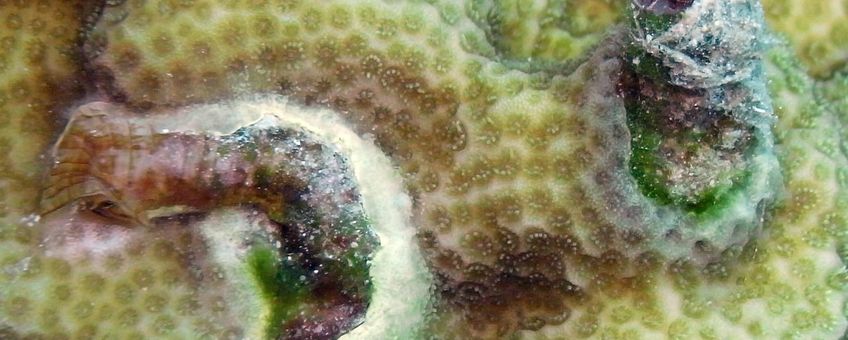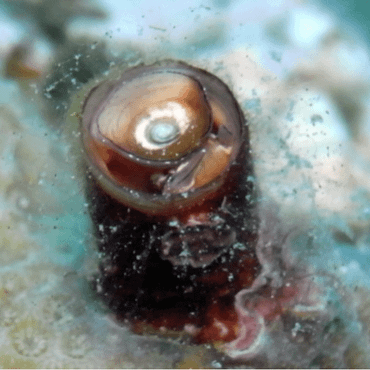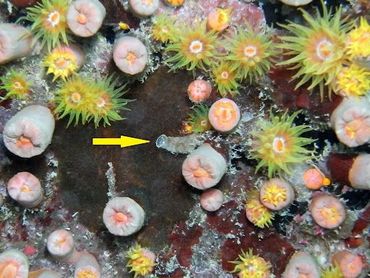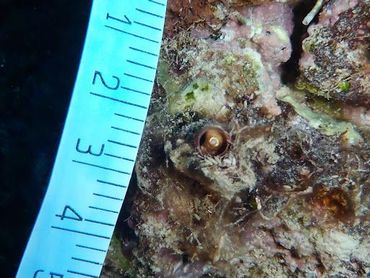
A newly found worm snail might indicate future threats to Caribbean coral reefs
Naturalis Biodiversity Center Worm snails are small, tube-dwelling snails found in tropical or subtropical waters. Some of them are known to form reef-like aggregations. Others live in association with corals, to which they often cause harm because of the toxic mucus that the snails secrete to hunt for prey (see close-up picture). Due to their shape, and as their name suggests, worm snails are often confused with actual worms, such as the Christmas tree worm (Spirobranchus giganteus), that also lives in association with corals. These worms, however, do not secrete mucus nets but have colourful tentacles with which they catch prey.
Worm snails are small, tube-dwelling snails found in tropical or subtropical waters. Some of them are known to form reef-like aggregations. Others live in association with corals, to which they often cause harm because of the toxic mucus that the snails secrete to hunt for prey (see close-up picture). Due to their shape, and as their name suggests, worm snails are often confused with actual worms, such as the Christmas tree worm (Spirobranchus giganteus), that also lives in association with corals. These worms, however, do not secrete mucus nets but have colourful tentacles with which they catch prey.
Old material, new discoveries
The snail from Curaçao seems to be from the genus Petaloconchus, but the exact species is unknown. Future research on the snail’s morphology and DNA may reveal its real identity, says lead author Bert Hoeksema. “This is an introduction article to create awareness,” he explains. “I am curious to find out if colleagues will find it elsewhere in the Caribbean, because nobody seemed to have found it before”.
The genus had mainly been recorded in the Indian Ocean with some populations on Pacific islands. A coral-dwelling worm snail in the Caribbean was a bit of a surprise.  However, after the researchers found the snail on Curaçao and started to look for it more closely, they ended up noticing it in pictures from earlier fieldwork. Worm snails appear in pictures taken on Curaçao as far back as 2014, as well as on pictures from the neighbouring island Bonaire. This suggests that the snail is not widespread in the Caribbean and may have been introduced in the southern Caribbean islands. The possibility of it existing elsewhere definitely cannot be excluded though, Hoeksema states.
However, after the researchers found the snail on Curaçao and started to look for it more closely, they ended up noticing it in pictures from earlier fieldwork. Worm snails appear in pictures taken on Curaçao as far back as 2014, as well as on pictures from the neighbouring island Bonaire. This suggests that the snail is not widespread in the Caribbean and may have been introduced in the southern Caribbean islands. The possibility of it existing elsewhere definitely cannot be excluded though, Hoeksema states.
A cryptogenic snail
Still, we do not know how it got to the Caribbean. The Caribbean worm snail populations are what ecologists call cryptogenic: from the Greek word kryptos, meaning hidden, and genesis, meaning origin – their origins are unknown or untraceable. The snail seems like an invasive species, and Hoeksema says he personally considers it “very likely invasive.” But it is still too early for such labels as there is no confirmed invasion corridor yet. The researchers speculate that in that case the snail might have come from the Pacific, where a similar snail has been observed.
Corals in danger?
 Given the damage worm snails do to corals, is there a possibility of negative consequences to the coral reef ecosystem? Hoeksema thinks not yet, as the snail is not very abundant. But he adds, “I’m not a conservation biologist. I just want to make colleagues and marine park managers aware of the snail.” In combination with factors like climate change and eutrophication, parasites like worm snails and the above-mentioned Christmas tree worm might generally become more abundant. All of them together may very well be harmful to coral reefs.
Given the damage worm snails do to corals, is there a possibility of negative consequences to the coral reef ecosystem? Hoeksema thinks not yet, as the snail is not very abundant. But he adds, “I’m not a conservation biologist. I just want to make colleagues and marine park managers aware of the snail.” In combination with factors like climate change and eutrophication, parasites like worm snails and the above-mentioned Christmas tree worm might generally become more abundant. All of them together may very well be harmful to coral reefs.
More information
- Read the original article ‘Host Range of the Coral-Associated Worm Snail Petaloconchus sp. (Gastropoda: Vermetidae), a Newly Discovered Cryptogenic Pest Species in the Southern Caribbean’ by Hoeksema et al., published March 2022 in Diversity.
Text: Kurt Kurat, Naturalis Biodiversity Center
Photos: Bert W. Hoeksema, Naturalis Biodiversity Center & Rijksuniversiteit Groningen
